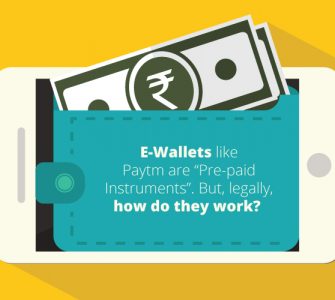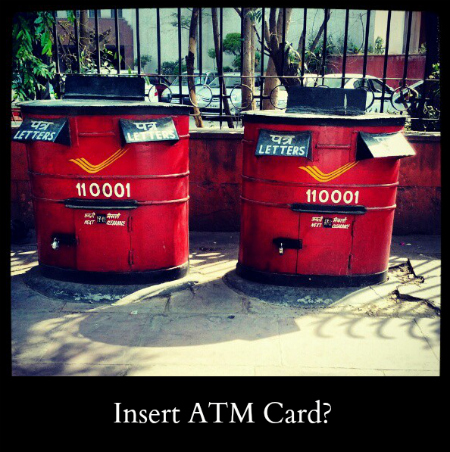 In the dawn of demonetisation, most of us have found ourselves adapting to new payment mechanisms and methods. The government’s strong push towards a cashless society seems to be ushering in the age of the e-wallet. Paytm alone is responsible for more transactions per day than the combined average daily usage of all the debit and credit cards in India. Mobile wallets, which many of you are using these days, are a type of pre-paid instrument. But what are pre-paid instruments? How do they work?
In the dawn of demonetisation, most of us have found ourselves adapting to new payment mechanisms and methods. The government’s strong push towards a cashless society seems to be ushering in the age of the e-wallet. Paytm alone is responsible for more transactions per day than the combined average daily usage of all the debit and credit cards in India. Mobile wallets, which many of you are using these days, are a type of pre-paid instrument. But what are pre-paid instruments? How do they work?
Here are some frequently asked questions, which should provide some clarity on the conceptual and regulatory framework behind pre-paid instruments in India.
I am hearing this term for the first time. What is a pre-paid instrument?
Pre-paid instruments are payment instruments that facilitate purchase of goods and services, including by way of funds transfer, against the value stored on such instruments. The value stored on these instruments represents the value paid for by the holders of such instruments.
The issuers of pre-paid instruments have tie-ups with various merchants, and you can use the value stored on your instruments to carry out transactions with these merchants.
Ok. That’s a very legalese definition. Did the Reserve Bank of India come up with it? What is the regulatory framework for pre-paid instruments?
Actually, yes! The Reserve Bank of India (RBI) first provided the guidelines on pre-paid instruments (let’s just call them PPIs) in 2009. Over the years the RBI, issued several notifications (yes, they were not as dynamic as today!) in relation to PPIs. It then decided to consolidate all these notifications in a Master Circular (which gets updated on a yearly basis). Pre-paid instruments are subject to the Payment and Settlement Systems Act, 2007.
The latest Master Circular – Policy Guidelines on Issuance and Operation of Pre-paid Payment Instruments in India was notified on 01 July 2016. You can have a look at that here. You will find all the definitions and other details in this Master Circular.
Cool! So I guess then a PPI is a regulated instrument and one needs to have the approval of the RBI to issue one?
Yes. The RBI provides licenses to issue PPIs. All persons proposing to operate payment systems and involved in the issuance of PPIs have to seek authorisation from the Department of Payment and Settlement Systems, RBI, under the Payment and Settlement Systems Act, 2007.
Ok. If mobile wallets are one type of PPIs, what are the other types?
PPIs can be issued as smart cards, magnetic strip cards, internet wallets, mobile accounts, mobile wallets, paper vouchers and any such instrument, which can be used to access the pre-paid amount. A mobile wallet (Paytm, Mobikwik etc.) is one type of PPI. However, this is a dynamic sector and entrepreneurs are devising new prepaid mechanisms everyday.

Broadly the RBI classifies PPIs into the following types: Closed, Semi-Closed and Open Payment Instruments.
What are Closed System Payment Instruments?
These are payment instruments issued by a person for facilitating the purchase of goods and services from him/it. These do not permit cash withdrawal or redemption. As these instruments do not facilitate payments and settlement for third party services, issue and operation of such instruments are not classified as payment systems. (A pre-paid card in your canteen or a food court can be considered a type of closed system payment instrument.)
What are Semi-Closed System Payment Instruments?
These are payment instruments, which can be used for purchase of goods and services, including financial services at a group of clearly identified merchant locations/establishments, which have a specific contract with the issuer to accept the payment instruments. These instruments also do not permit cash withdrawal or redemption by the holder.
Mobile wallets like Paytm and Mobikwik are semi-closed payment instruments.
What are Open System Payment Instruments?
These are payment instruments, which can be used for purchase of goods and services, including financial services like funds transfer at any card accepting merchant locations (point of sale terminals) and also permit cash withdrawal at ATMs.
Debit cards are open system payment instruments.
Are there any limits in relation to the value that I can store in the PPIs?
Currently, the limit is Rs. 20,000 per month for PPIs where minimum details of the customers have been collected.
This limit can be extended up to Rs 1,00,000 per month after collecting the appropriate KYC (Know Your Customer) documents from the holders.
Ok. So what can I do with my pre-paid instruments?
Let’s only consider semi-closed PPIs from now on, as these are the most commonly used. Your scope of usage of a semi-closed PPI is dependent upon the number of merchants the PPI issuer has tied up with. Generally you can use your PPI for payment of utilities with these merchants and for transferring money to other PPIs.
e.g. Paytm has a tie up with Uber and not with Ola. So you can use your Paytm wallet to make a payment for Uber but not for Ola.
Ok. So what happens to the money after I transfer it to my PPI?
Every PPI issuer (like Paytm, Mobikwik etc.) is required to create an escrow account with a bank, where all the money collected from its customers are credited. This account is a non-interest bearing account. The PPI issuer is required to create a security on this account in favour of the PPI holders (customers like you and me). Therefore the holders are secured and in the event of liquidation/bankruptcy of the PPI issuer, the merchants/PPI holders shall be given preference to the other creditors of the PPI issuer.


There are strict norms, which regulate any debit or credit of this escrow account. However at no point of time can the amount in the escrow account be less than the aggregate of the balance amount in all the corresponding PPIs and all pending payment instructions in favour of the merchants. So don’t worry, your money is safe with a PPI issuer!
Can I redeem the money stored in my PPI?
No. You are not allowed to redeem your money from a semi-closed PPI. However if that particular PPI is being closed or if the RBI decides to stop this entire product of PPIs (highly unlikely, the RBI usually does not reverse a decision), the customers shall be allowed to redeem the amounts stored in the PPI, within the expiry date of the PPI.
Who can issue PPIs? Are all PPI issuers NBFCs or banks?
Only banks can issue Open PPIs. Non Banking Financial Companies (NBFCs) and other persons can issue Closed and Semi-closed PPIs. These persons need to have a minimum paid-up capital of Rs. 500 lakh and minimum positive net-worth of Rs. 100 lakh at all times. Only companies incorporated in India are eligible.
As mentioned earlier, the authorisation of the RBI is required.
If I keep my money in my bank account it earns me interest. Can I earn interest on the amount stored in my pre-paid instrument?
The money in the wallet or PPI can only be used for transactions against the value stored in such instruments.
You will not earn interest on the amount stored in the wallet.
I heard of an offer where I can get cashback points if I use a mobile wallet. How does this work?
These are usually marketing offers. The merchant may be offering the product at a discount to increase sales. The discounted amount is then credited back into the PPI.
At times, the PPI issuer may also credit the PPI with an additional amount to incentivise customers. A PPI can be funded/reloaded by third parties, so the PPI issuer is transferring the cashback amount to your PPI.
Hope this is of help! Do take some time to go through the RBI Master Circular for more details.
 Abhishek is a legal and business strategy consultant with ePaylater, one of India’s first one- click checkout payment solutions. This article should not be construed as legal advice. The views expressed in this article are his personal views and opinions. He can be reached at abhishek.ray@epaylater.in.
Abhishek is a legal and business strategy consultant with ePaylater, one of India’s first one- click checkout payment solutions. This article should not be construed as legal advice. The views expressed in this article are his personal views and opinions. He can be reached at abhishek.ray@epaylater.in.

